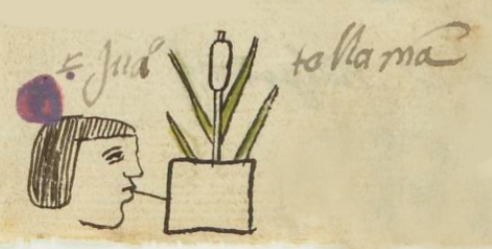Tolama (MH711r)
This compound glyph for the personal name, Tolama (“Tule Paper”), is attested here as a man’s name. It shows a frontal view of an upright tule plant with four, long, spiky green leaves, two on each side. Up the middle is a white stem with a white shape at the top that resembles a cattail. Below the plant is a white square that is meant to convey “paper” (amatl).
Stephanie Wood
Tule paper is known in Mexico. For a photo, click here. Of course, most paper (amatl) came from the bark of a tree.
Stephanie Wood
1560
Jeff Haskett-Wood
papeles, tules, nombres de hombres

tol(in), tules, rushes, reeds, https://nahuatl.wired-humanities.org/content/tolin-1
ama(tl), paper, https://nahuatl.wired-humanities.org/content/amatl
Papel de Tules
Stephanie Wood
Matrícula de Huexotzinco, folio 711r, World Digital Library, https://www.loc.gov/resource/gdcwdl.wdl_15282/?sp=500&st=image
This manuscript is hosted by the Library of Congress and the World Digital Library; used here with the Creative Commons, “Attribution-NonCommercial-ShareAlike 3.0 License” (CC-BY-NC-SAq 3.0).




